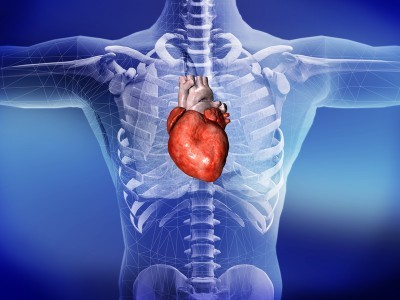 February is National Heart Month! The perfect time to highlight the curious connection between heart disease and osteoporosis.
February is National Heart Month! The perfect time to highlight the curious connection between heart disease and osteoporosis.
It seems strange that the weakening of hard, rigid bones could be associated with the stiffening of supple arterial tissue. However, studies show that people with heart disease are more likely to fracture a bone due to osteoporosis and, oddly enough, postmenopausal women with osteoporosis are at an increased risk of cardiovascular disease. (1,2)
Once viewed as being independent conditions, research showing a link between heart disease and osteoporosis suggests that the conditions may have similar causes.
What’s the Link?
Osteoporosis and cardiovascular disease share many common conventional risk factors such as sedentary lifestyle, smoking, diabetes, hypertension, stress and aging. However the two conditions are further linked through menopause, inflammation, oxidative stress, and vitamin deficiencies.
The decline of estrogen in women following menopause increases the risk of both osteoporosis and cardiovascular disease. For most of our life, estrogen aids in maintaining our bone density. However, with the onset of menopause, the drop in estrogen leads to bone breakdown and decreased calcium absorption. The incidence of heart attacks in women also increases dramatically after menopause. This can be attributed to the lack of estrogen as well and its cardio-protective effects. Estrogen not only has a positive effect on the inner layer of artery walls, helping to keep blood vessels flexible, but also maintains healthy cholesterol levels.
There is also an association between systemic inflammation in both cardiovascular disease and osteoporosis. C-reactive protein (CRP) is one of the key markers of inflammation and has been found to be a significant predictor of fracture as well as cardiovascular disease. (3) Inflammation affects the blood vessel walls by forming calcifications that lead to plaques. Inflammation has the opposite effect on the skeletal system and actually stimulates bone breakdown. Studies have shown that women with the highest levels of inflammation markers are up to three times more likely to experience fractures. (4)
Oxidative stress occurs when there is an imbalance between the production of free radicals and the body’s ability to neutralize them through antioxidants. Oxidative stress not only plays a fundamental role in the development of cardiovascular disease but also osteoporosis. Oxidative stress inhibits osteoblasts (bone formation cells) and stimulates the production of osteoclast (bone resorption cells).
Vitamin deficiency. A significant risk factor in the development of cardiovascular disease is the calcification of heart valves and blood vessels. Ironically, osteoporosis occurs with a loss of calcium from bone. In both instances, vitamin deficiencies, could be an underlying factor. Vitamins D and K are critically important to the absorption and transportation of calcium in our system. Vitamin D helps you absorb calcium and vitamin K2 directs your body to deposit the calcium into your bones and teeth, and not in your arteries. Insufficient vitamin K accelerates arterial calcification, while preventing calcium uptake into your bones. (5) Vitamin D also regulates blood pressure and cardiac function and appears to reduce inflammation. (6) Both these vitamins provide critical benefits to the bone as well as to the cardiovascular system.
Your body is a complex organism in which every system and organ is interrelated. No disease or condition exits on its own.
The changes you make to prevent and address osteoporosis will benefit your health in every way.
Call me to find out more on how taking care of your BONES will also help your HEART!

Susan Brady
is a Physical Therapist,
Nutrition Consultant and
Doctor of Integrative Medicine.
She has been treating women with osteoporosis for over 30 years and is dedicated to helping people achieve
lasting good health and vitality.
Want to learn more about how you can improve your bone health? Contact me for a free 15 minute phone consult to learn more about the BONES Method™ and how it can help you achieve strong, healthy bones for life!
References:
1. Paccou, J., Edwards, M. H., Ward, K. A., Jameson, K. A., Moss, C. L., Harvey, N. C., . . . Cooper, C. (2015). Ischemic heart disease is associated with lower cortical volumetric bone mineral density of distal radius. Osteoporosis International, 26(7), 1893-1901. doi:10.1007/s00198-015-3132-z
2. Liu, N., Chen, J., Zhang, K., & Tang, Z. (2016). A community-based study of the relationship between coronary artery disease and osteoporosis in Chinese postmenopausal women. Coronary Artery Disease, 27(1), 59-64. doi:10.1097/mca.0000000000000306
3. Ishii S, Cauley JA, Greendale GA, et al. C-reactive protein, bone strength, and nine-year fracture risk: data from the Study of Women’s Health Across the Nation (SWAN). J Bone Miner Res. 2013;28(7):1688-1698.
4. Barbour KE, Boudreau R, Danielson ME, et al. Inflammatory markers and the risk of hip fracture: the Women’s Health Initiative. J Bone Miner Res. 2012;27(5):1167-1176.
5. Vitamin K intake and all-cause and cause specific mortality. (n.d.). Retrieved February 23, 2018, from https://www.bing.com/cr?
6. Wimalawansa, S. J. (2018). Vitamin D and cardiovascular diseases: Causality. The Journal of Steroid Biochemistry and Molecular Biology, 175, 29-43. doi:10.1016/j.jsbmb.2016.12.016






